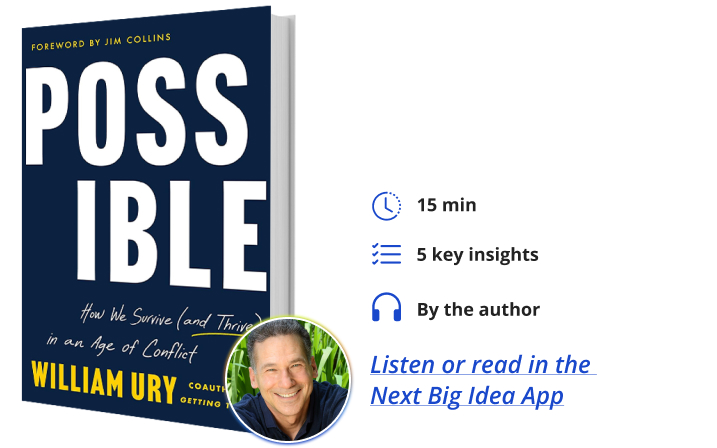William Ury is an anthropologist by training, professional mediator, and co-founder of Harvard’s Program on Negotiation. He also helped found the International Negotiation Network with former President Jimmy Carter, was a consultant for the Crisis Management Center at the White House during the Cold War, and co-founded the International Climate Parliament. He has advised and mediated many world leaders through conflicts as intense as ethnic and civil wars and is one of the world’s leading experts on negotiation.
Below, William shares five key insights from his new book, Possible: How We Survive (and Thrive) in an Age of Conflict. Listen to the audio version—read by William himself—in the Next Big Idea App.

1. Don’t try to end conflict: transform it.
We can’t end conflict—nor should we. Conflict is natural, a part of life. We may actually need more conflict, not less. By that, I mean healthy conflict that allows us to engage our differences, grow, and change what needs to be changed. Healthy conflict can make our relationships strong, our democracy vibrant, and our economy thriving.
The challenge we face is not how to get rid of conflict but how to handle it in a different way. All too often, we fall into what I call the three A trap:
- Attack: This usually provokes counterattack—an eye for an eye, and we all go blind.
- Avoid: We ignore the problem, which doesn’t solve anything.
- Accommodate (or appease): We give in.
Often, we do all three things. We avoid for a while, we accommodate, and then we lose it and go on the attack.
To get out of the three A trap we must do the exact opposite, which is to lean into the conflict with curiosity, embrace it with creativity, and transform it with collaboration. By transform, I mean changing the form of conflict from destructive fighting into constructive negotiation.
If we want to transform our conflicts so we can navigate these polarized times, my experience suggests we will need three things: a clear perspective, a way out, and lots of help from people around us.
2. Get some perspective: go to the balcony.
When it comes to conflict in these tough times, we are often our own worst enemies. The biggest lesson I have learned since coauthoring Getting to Yes decades ago is that the biggest obstacle to getting what I want is usually not what I think it is. It’s not the difficult person on the other side of the table. It is the person on this side of the table—I am the obstacle. It is the person I look at in the mirror every morning.
It is our natural human tendency to react out of fear and anger. Humans are reaction machines. As the old saying goes, when angry, you will make the best speech you will ever regret. The alternative to reacting is pausing for a moment to get some perspective. Imagine yourself on a stage and then go to the balcony—a place of calm where you can keep your eyes on the prize and see the bigger picture. Think about what you really want, your deeper interests, concerns, and aspirations, and think about how you can best satisfy them.
I learned this balcony lesson most dramatically when, in the middle of a political mediation, I was confronted by the president of Venezuela, Hugo Chavez, in front of his entire cabinet. He asked me how things were going. I made the mistake of saying there had been some progress. “Progress? What are you talking about? Are you a fool not seeing the dirty tricks those traitors in the opposition are up to?” He leaned in close to my face so I could feel his hot breath as he shouted at me. I felt embarrassed and flustered and was about to react defensively when I caught myself and thought, What am I trying to do here? To calm the situation, is it really going to help if I get into an argument with the president of Venezuela? So, I bit my tongue and listened to him instead.
“I learned then that the greatest power in negotiation is the power not to react and go to the balcony instead.”
After thirty minutes of him shouting at me, I saw his shoulders sink and he asked in a weary tone, “Ury, what should I do?” That, my friends, is the faint sound of a human mind opening. That was my chance.
So, I said, “Mr. President, it is almost Christmas. People are exhausted from the conflict. Why don’t you call a truce over the holidays?”
He paused for a moment, then announced, “That’s an excellent idea. I’m going to propose that in my next speech.” He clapped me on the back. His mood had completely shifted. I learned then that the greatest power in negotiation is the power not to react and go to the balcony instead.
Think about your favorite way to go to the balcony. It could be taking a deep breath, taking a break, or going for a walk. Remember that we can only influence the other side to the extent we can influence ourselves. Negotiation is an inside job; it works from the inside out. The best way to start is to stop. That’s how you set up negotiations for success.
3. Find a way out: build a golden bridge.
In today’s tough conflicts, we need to be able to find a way out: out of the labyrinth, out of destructive fights. The other side may be far from cooperative. They may dig in and refuse to budge. They can pressure, attack, and threaten. There is a huge chasm between where you stand and where they stand, and that chasm is filled with anxiety, doubt, unmet needs, and distrust. Your challenge is building a bridge over the chasm—a golden bridge—an attractive way out.
Instead of pushing, do the opposite and attract. Instead of making it harder for them, your job is to make it easier for the other side to make the decision you want them to make. You need to leave your thinking for a moment and start the conversation where their mind is. Listen to them, put yourself in their shoes, and seek to understand their perceptions and feelings. How can we possibly change their mind if we don’t know where their mind is? We need to understand their needs and concerns.
One of my favorite exercises is to write the other side’s victory speech as a thought experiment. Imagine the other side has already said yes to your proposal. Now they have to explain to the people they care about, their constituency, why they said yes. What would be the three key points of their victory speech? What would be persuasive? In other words, start at the end and work backward.
Now, think about how you can help them deliver this victory speech. Whether it is asking your boss for a raise or figuring out how to end a war, I find this thought experiment can open creative possibilities we hadn’t imagined before.
4. Get some help: engage the third side.
It’s not easy to go to the balcony or build a golden bridge. Where can we find help?
The classic mistake people make when they fall into conflict is to reduce conflict to two sides—us against them, union vs. management, one political party vs. another, one nation warring with another.
We forget that in any conflict, there is always a third side, and that’s the people around us: friends, family, colleagues, neighbors, and the community. The third side is a huge untapped potential that can help the parties calm down and go to the balcony, bringing them together to talk and help find a golden bridge.
A difficult conflict may require an intervention from the community. I think of it as a swarm from the third side. A critical mass of persuasive influence and ideas from the community can help the parties find a way out.
“A difficult conflict may require an intervention from the community.”
I once served as a negotiation advisor to the President of Colombia, Juan Manuel Santos, as he was trying to put an end to a fifty-year civil war that had taken hundreds of thousands of lives and eight million victims. Most observers thought the conflict was utterly intractable and impossible to resolve.
I was part of a team of international advisors who served as a balcony for the president, offering him perspective so he could figure out a way through the labyrinth. We made over 25 trips to Colombia, helping him build a golden bridge, starting with a victory speech for the guerrilla leaders.
But even more was needed. To succeed, he had to win over the political patrons of the guerrillas, Fidel Castro and Hugo Chavez, so that they would coax the guerrillas to the negotiating table. He also had to build support for a peace process within the country among the business community and the military, who were intensely skeptical.
It took five years of huge collective work, but, in the end, the guerrillas laid down their weapons, Santos won the Nobel Peace Prize, and the longest-running war in the Americas came to an end. In tough conflicts like this, the key is to engage the surrounding community—the third side—and turn it into a winning coalition for a peaceful agreement.
5. Be a possibilist.
After all these years of working on intractable conflicts, people often ask me if I’m an optimist or a pessimist. I like to answer that I am a possibilist. A possibilist is someone who believes in human potential—in this case, our natural capacity to transform conflicts.
I am a possibilist because I’ve seen the impossible become possible with my own eyes—in boardroom battles, labor strikes, family feuds, and wars around the world. No conflict is too difficult. Since conflicts are made by humans, they can be transformed by humans. The path to possible is to go to the balcony, build a golden bridge, and engage the third side.
We live in a time of great paradox. Never before in human evolution, thanks to our technologies, have we enjoyed such an abundance of opportunities to solve the world’s problems and live the life we want for ourselves and our children. Yet, with the rapid changes and disruptions amplified by the same technologies, we face a wave of destructive conflict that’s polarizing every domain of life. How can we navigate these turbulent times so we can benefit from the enormous opportunities around us?
The balcony, the bridge, and the third side are innate human potentials. We just need to remember to develop them. I hope you will make them your close friends and allies, always at your disposal. That’s how I believe we can navigate this turbulent age of conflict and benefit from the enormous opportunities we have. The choice is ours. If we can transform our conflicts, we can transform our lives, and we can transform our world.
To listen to the audio version read by author William Ury, download the Next Big Idea App today:































